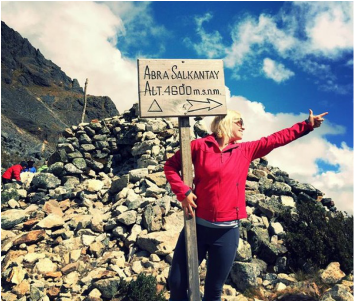|
On my recent trek through Peru, we tapped into the edge of the largest and most biodiverse tropical rainforest in the world, the Amazon. Covering over 2 million square miles, 60% of the forest is contained within Brazil, followed by Peru with 13%, and Colombia with 10% and with minor amounts in Venezuela, Ecuador, Bolivia, Guyana, Suriname and French Guiana. This spectacular world of its own originally flows with abundance. The Amazon Rainforest is considered “The lungs of the Earth” as more than 20% of the world’s oxygen is produced by the Amazon. One out of every ten of the world’s known species live in the Amazon and there are around 40,000 plant species, 1,300 bird species, 3,000 types of fish, 430 mammals and 2.5 million different insects. Further, there are around 3000 fruits, and in the west we make use of only around 200 of them. However, indigenous tribes make use of over 2000 of these fruits!
2 Comments
Huffing and puffing, I arrived at the top of this pass, 15, 225 feet above sea level. Literally breathless, I stood in awe of this majestic peak, soaring another 5,000 feet above to its summit at 20,574. Deep inhale through the nose, quick exhale through the mouth. This technique allowed me to receive more oxygen in my body. Salkantay Mountain is a large, steep peak. The word meaning wild or invincible, and is often translated as "Savage Mountain." Very few have actually survived a rock climbing adventure up to its peak. Salkantay lies north of Machu Picchu and is the highest peak of the Willkapampa mountain range, part of the Peruvian Andes. The Incas associated the alignment of Salkantay with concepts of rain and fertility, and they considered this mountain to be one of the principal deities controlling weather and fertility in the region west of Cusco.
After setting my bags down at the hostel, I ventured out to take in my first experiences of the extremely colorful city, Cusco, the former Inca capital and now gateway to Machu Picchu, in Peru.
I wondered over to the Centro Mercado to get an idea of all of the options for souvenirs and gifts to bring back for myself and my friends. Cusco has one of the largest varieties of arts and crafts on earth. This feast for your eyes can be overwhelming. I found it challenging to focus on one object with so many objects coming at me. The assortment of color, creativity and multiple functions of Peru’s folk art has made it a fundamental activity, not just for Peru’s cultural identity, but also as a way of life for thousands of families and even entire communities. They have an extensive range of handmade production, with much of it an inheritance from their Inca ancestors. I was drawn to many of the alpaca and llama fabrics. Alpacas and llamas have been bred in South America for thousands of years. These camel and sheep-like creatures were a crucial component of ancient life in the Andes, as it provided not only warm clothing, but also meat. Also known as "The Fiber of the Gods", Alpaca was used to make clothing for royalty. They were first domesticated by the ancient tribes of the Andean highlands. Two-thousand-year-old Paracas textiles are thought to include alpaca fiber. Alpaca hair is a soft, durable, luxurious and silky natural fiber. While similar to sheep’s wool, it is warmer, not prickly, and is hypoallergenic. Then and now, alpaca is used primarily for clothing, especially sweaters. Because it was coarser than alpaca, Llama wool is used mostly for utilitarian items such as outer clothing, blankets, ropes, rugs, hats, mitts, scarves, leg-warmers, and backpacks. |
Hannah Faulkner
|




















 RSS Feed
RSS Feed